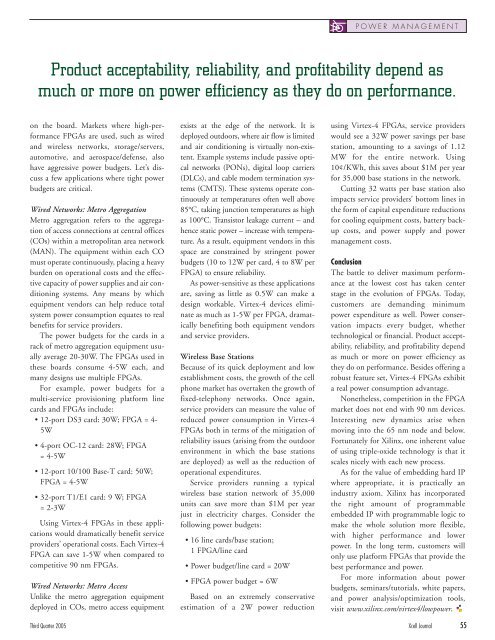Design Challenges: Avoiding the Pitfalls, winning the game - Xilinx
Design Challenges: Avoiding the Pitfalls, winning the game - Xilinx
Design Challenges: Avoiding the Pitfalls, winning the game - Xilinx
You also want an ePaper? Increase the reach of your titles
YUMPU automatically turns print PDFs into web optimized ePapers that Google loves.
on <strong>the</strong> board. Markets where high-performance<br />
FPGAs are used, such as wired<br />
and wireless networks, storage/servers,<br />
automotive, and aerospace/defense, also<br />
have aggressive power budgets. Let’s discuss<br />
a few applications where tight power<br />
budgets are critical.<br />
Wired Networks: Metro Aggregation<br />
Metro aggregation refers to <strong>the</strong> aggregation<br />
of access connections at central offices<br />
(COs) within a metropolitan area network<br />
(MAN). The equipment within each CO<br />
must operate continuously, placing a heavy<br />
burden on operational costs and <strong>the</strong> effective<br />
capacity of power supplies and air conditioning<br />
systems. Any means by which<br />
equipment vendors can help reduce total<br />
system power consumption equates to real<br />
benefits for service providers.<br />
The power budgets for <strong>the</strong> cards in a<br />
rack of metro aggregation equipment usually<br />
average 20-30W. The FPGAs used in<br />
<strong>the</strong>se boards consume 4-5W each, and<br />
many designs use multiple FPGAs.<br />
For example, power budgets for a<br />
multi-service provisioning platform line<br />
cards and FPGAs include:<br />
• 12-port DS3 card: 30W; FPGA = 4-<br />
5W<br />
• 4-port OC-12 card: 28W; FPGA<br />
= 4-5W<br />
• 12-port 10/100 Base-T card: 50W;<br />
FPGA = 4-5W<br />
• 32-port T1/E1 card: 9 W; FPGA<br />
= 2-3W<br />
Using Virtex-4 FPGAs in <strong>the</strong>se applications<br />
would dramatically benefit service<br />
providers’ operational costs. Each Virtex-4<br />
FPGA can save 1-5W when compared to<br />
competitive 90 nm FPGAs.<br />
Wired Networks: Metro Access<br />
Unlike <strong>the</strong> metro aggregation equipment<br />
deployed in COs, metro access equipment<br />
exists at <strong>the</strong> edge of <strong>the</strong> network. It is<br />
deployed outdoors, where air flow is limited<br />
and air conditioning is virtually non-existent.<br />
Example systems include passive optical<br />
networks (PONs), digital loop carriers<br />
(DLCs), and cable modem termination systems<br />
(CMTS). These systems operate continuously<br />
at temperatures often well above<br />
85°C, taking junction temperatures as high<br />
as 100°C. Transistor leakage current – and<br />
hence static power – increase with temperature.<br />
As a result, equipment vendors in this<br />
space are constrained by stringent power<br />
budgets (10 to 12W per card, 4 to 8W per<br />
FPGA) to ensure reliability.<br />
As power-sensitive as <strong>the</strong>se applications<br />
are, saving as little as 0.5W can make a<br />
design workable. Virtex-4 devices eliminate<br />
as much as 1-5W per FPGA, dramatically<br />
benefiting both equipment vendors<br />
and service providers.<br />
Wireless Base Stations<br />
Because of its quick deployment and low<br />
establishment costs, <strong>the</strong> growth of <strong>the</strong> cell<br />
phone market has overtaken <strong>the</strong> growth of<br />
fixed-telephony networks. Once again,<br />
service providers can measure <strong>the</strong> value of<br />
reduced power consumption in Virtex-4<br />
FPGAs both in terms of <strong>the</strong> mitigation of<br />
reliability issues (arising from <strong>the</strong> outdoor<br />
environment in which <strong>the</strong> base stations<br />
are deployed) as well as <strong>the</strong> reduction of<br />
operational expenditures.<br />
Service providers running a typical<br />
wireless base station network of 35,000<br />
units can save more than $1M per year<br />
just in electricity charges. Consider <strong>the</strong><br />
following power budgets:<br />
• 16 line cards/base station;<br />
1 FPGA/line card<br />
• Power budget/line card = 20W<br />
• FPGA power budget = 6W<br />
Based on an extremely conservative<br />
estimation of a 2W power reduction<br />
POWER MANAGEMENT<br />
Product acceptability, reliability, and profitability depend as<br />
much or more on power efficiency as <strong>the</strong>y do on performance.<br />
using Virtex-4 FPGAs, service providers<br />
would see a 32W power savings per base<br />
station, amounting to a savings of 1.12<br />
MW for <strong>the</strong> entire network. Using<br />
10¢/KWh, this saves about $1M per year<br />
for 35,000 base stations in <strong>the</strong> network.<br />
Cutting 32 watts per base station also<br />
impacts service providers’ bottom lines in<br />
<strong>the</strong> form of capital expenditure reductions<br />
for cooling equipment costs, battery backup<br />
costs, and power supply and power<br />
management costs.<br />
Conclusion<br />
The battle to deliver maximum performance<br />
at <strong>the</strong> lowest cost has taken center<br />
stage in <strong>the</strong> evolution of FPGAs. Today,<br />
customers are demanding minimum<br />
power expenditure as well. Power conservation<br />
impacts every budget, whe<strong>the</strong>r<br />
technological or financial. Product acceptability,<br />
reliability, and profitability depend<br />
as much or more on power efficiency as<br />
<strong>the</strong>y do on performance. Besides offering a<br />
robust feature set, Virtex-4 FPGAs exhibit<br />
a real power consumption advantage.<br />
None<strong>the</strong>less, competition in <strong>the</strong> FPGA<br />
market does not end with 90 nm devices.<br />
Interesting new dynamics arise when<br />
moving into <strong>the</strong> 65 nm node and below.<br />
Fortunately for <strong>Xilinx</strong>, one inherent value<br />
of using triple-oxide technology is that it<br />
scales nicely with each new process.<br />
As for <strong>the</strong> value of embedding hard IP<br />
where appropriate, it is practically an<br />
industry axiom. <strong>Xilinx</strong> has incorporated<br />
<strong>the</strong> right amount of programmable<br />
embedded IP with programmable logic to<br />
make <strong>the</strong> whole solution more flexible,<br />
with higher performance and lower<br />
power. In <strong>the</strong> long term, customers will<br />
only use platform FPGAs that provide <strong>the</strong><br />
best performance and power.<br />
For more information about power<br />
budgets, seminars/tutorials, white papers,<br />
and power analysis/optimization tools,<br />
visit www.xilinx.com/virtex4/lowpower.<br />
Third Quarter 2005 Xcell Journal 55

















